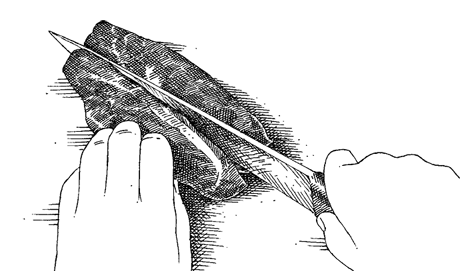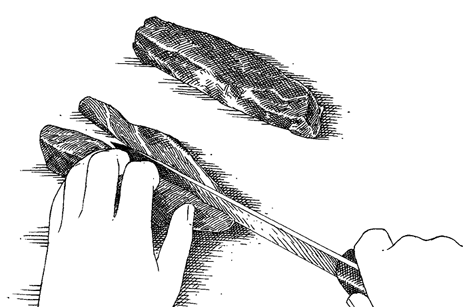The Cook's Illustrated Cookbook (55 page)
Read The Cook's Illustrated Cookbook Online
Authors: The Editors at America's Test Kitchen
Tags: #Cooking


1.
Halve each steak lengthwise, leaving gristle on one half.

2.
Cut away gristle from half to which it is still attached, then cut trimmed meat into pieces.
![]() WHY THIS RECIPE WORKS
WHY THIS RECIPE WORKS
Classic beef Burgundy combines satisfyingly large chunks of tender meat with a velvety sauce brimming with the flavor of good Burgundy wine and studded with caramelized mushrooms and pearl onions. Unfortunately, we’ve seen too many versions of this rustic French dish end up with tough meat or a dull sauce. For the best beef Burgundy, we started by rendering salt pork until crisp, then browned large chunks of beef chuck roast in the rendered fat. For the braising liquid, a combination of chicken broth and water, enhanced with a small amount of dried porcini mushrooms and tomato paste, provided balanced, well-rounded flavor. Using anything less than a full bottle of red wine left the sauce lacking and unremarkable. We deglazed the pan twice, used a roux to thicken the sauce, and then added the wine. While the liquid reduced to a velvety sauce, we simmered pearl onions then sautéed them briefly with mushrooms to create the perfect garnish for our rich, tender beef.
SERVES 6
For the wine, we like to use a Burgundy or Pinot Noir. If you cannot find salt pork, thick-cut bacon can be substituted. Cut it crosswise into ¹⁄
4
-inch pieces and treat it just as you would salt pork, but note that you will have no rind to include in the vegetable and herb bouquet. Boiled potatoes are the traditional accompaniment, but mashed potatoes or buttered noodles are nice as well.
BEEF STEW
6 | ounces salt pork, rind removed and reserved, salt pork cut into 1 by ¹⁄ |
2 | onions, chopped coarse |
2 | carrots, chopped coarse |
1 | head garlic, cloves separated and crushed but unpeeled |
¹⁄ | ounce dried porcini mushrooms, rinsed (optional) |
10 | sprigs fresh parsley, torn into pieces |
6 | sprigs fresh thyme |
2 | bay leaves, crumbled |
¹⁄ | teaspoon whole black peppercorns |
1 | (4- to 4¹⁄ |
Salt and pepper | |
2¹⁄ | cups water |
4 | tablespoons unsalted butter, cut into 4 pieces |
¹⁄ | cup all-purpose flour |
1³⁄ | cups low-sodium chicken broth |
1 | (750-ml) bottle red wine |
1 | teaspoon tomato paste |
ONION AND MUSHROOM GARNISH
1 | cup frozen pearl onions, thawed |
1 | tablespoon unsalted butter |
1 | tablespoon sugar |
Salt and pepper | |
³⁄ | cup water |
10 | ounces white mushrooms, trimmed, whole if small, halved if medium, quartered if large |
2 | tablespoons brandy |
3 | tablespoons minced fresh parsley |
1. FOR THE STEW:
Bring salt pork, reserved salt pork rind, and 3 cups water to boil in medium saucepan over high heat. Boil 2 minutes, then drain well.
2.
Cut two 22-inch lengths cheesecloth and place on top of each other. Wrap onions, carrots, garlic, porcini mushrooms, parsley, thyme, bay leaves, peppercorns, and blanched salt pork rind in cheesecloth and set in Dutch oven. Adjust oven rack to lower-middle position and heat oven to 300 degrees.
3.
Heat salt pork in large skillet over medium heat and cook until lightly browned and crisp, about 12 minutes. Using slotted spoon, transfer to pot; pour off all but 2 teaspoons fat and reserve. Season beef with salt and pepper. Increase heat to high and brown half of beef in single layer, turning once or twice, until deep brown, about 7 minutes; transfer browned beef to pot. Pour ¹⁄
2
cup water into skillet and scrape pan to loosen browned bits; add liquid to pot.
4.
Return skillet to high heat and add 2 teaspoons reserved pork fat; swirl to coat pan bottom. When fat begins to smoke, brown remaining beef in single layer, turning once or twice, until deep brown, about 7 minutes; transfer browned beef to pot. Pour ¹⁄
2
cup water into skillet and scrape pan to loosen browned bits; add liquid to pot.
5.
Melt butter in now-empty skillet over medium heat. Whisk in flour until evenly moistened and cook, whisking constantly, until mixture has toasty aroma and resembles light-colored peanut butter, about 5 minutes. Gradually whisk in chicken broth and remaining 1¹⁄
2
cups water; increase heat to medium-high and bring to simmer, stirring frequently, until thickened. Pour mixture into pot. Add 3 cups wine, tomato paste, and salt and pepper to taste to pot and stir to combine. Set pot over high heat and bring to boil. Cover and transfer to oven; cook until meat is tender, 2¹⁄
2
to 3 hours.
6.
Carefully remove pot from oven and, using tongs, transfer vegetable and herb bouquet to strainer set over pot. Press out liquid into pot and discard bouquet. With slotted spoon, remove beef to medium bowl; set aside. Allow braising liquid to settle for 15 minutes; with large spoon, skim fat from surface and discard.
7.
Bring liquid in pot to boil over medium-high heat. Simmer briskly, stirring occasionally to ensure that bottom is not burning, until sauce is reduced to about 3 cups and thickened to consistency of heavy cream, 15 to 25 minutes.
8. FOR THE GARNISH:
While sauce is reducing, bring pearl onions, butter, sugar, ¹⁄
4
teaspoon salt, and ¹⁄
2
cup water to boil in medium skillet over high heat; cover and reduce heat to medium-low and simmer, shaking pan occasionally, until onions are tender, about 5 minutes. Uncover, increase heat to high, and simmer until all liquid evaporates, about 3 minutes. Add mushrooms and ¹⁄
4
teaspoon salt; cook, stirring occasionally, until liquid released by mushrooms evaporates and vegetables are browned and glazed, about 5 minutes. Transfer vegetables to large plate and set aside. Add remaining ¹⁄
4
cup water to skillet and stir to loosen browned bits. When pan bottom and sides are clean, add liquid to reducing sauce.
9.
When sauce has reduced to about 3 cups and thickened to the consistency of heavy cream, reduce heat to medium-low; stir in beef, mushrooms and onions (and any accumulated juices), remaining wine from bottle, and brandy into pot. Cover pot and cook until just heated through, 5 to 8 minutes. Season with salt and pepper to taste and serve, sprinkling individual servings with minced parsley.
TO MAKE AHEAD:
In step 6, use tongs to transfer vegetable and herb bouquet to mesh strainer set over pot. Press out liquid into pot and discard bouquet. Let beef cool to room temperature in liquid in pot, then cover and refrigerate for up to 2 days. With slotted spoon, skim fat from surface and discard. Set pot over medium-high heat and bring to simmer; with slotted spoon remove beef to medium bowl and set aside. Simmer sauce briskly, stirring occasionally to ensure that bottom is not burning, until reduced to about 3 cups and thickened to consistency of heavy cream. Continue with recipe from step 8.
HOW MUCH ALCOHOL IS COOKED OFF?
We are frequently asked how much alcohol is cooked off from wine, beer, and spirits used to flavor dishes. The common belief is that the alcohol (ethanol) completely burns off with time (or direct heat—see
“TEST KITCHEN TIP NO. 148 TIPS FOR FEARLESS FLAMBÉING”
), but we’ve found out that it’s not that simple.
When alcohol and water mix, they form a solution called an azeotrope—a mixture of two different liquids that behaves as if it were a single compound. Even though alcohol evaporates at a lower temperature than water, the vapors coming off of an alcohol-water azeotrope will contain both alcohol and water—they become inextricably mixed.
We measured the alcohol content of the stew liquid in our Beef Burgundy before it went into the oven. Every hour, we sampled the liquid to measure the alcohol concentration, and every time, it had dropped—but not as much as might be expected. After three hours of stewing, the alcohol concentration of the stew liquid had decreased by 60 percent. A major reason for the retention of alcohol in this dish is the use of a lid. If the surface of the liquid is not ventilated, alcohol vapor will accumulate, reducing further evaporation. Because most stews and braises are cooked in lidded pots, significant alcohol retention is the rule rather than the exception, even after hours of cooking.
Alcohol cooked in a skillet, say for a pan sauce, evaporates faster and more completely if allowed to reduce almost completely before liquids are added, though a certain percentage of alcohol will remain. Our conclusion? Though it is possible to remove the majority of alcohol in food through cooking, traces will always remain.
![]() WHY THIS RECIPE WORKS
WHY THIS RECIPE WORKS
We started our pot roast by selecting a well-marbled chuck-eye roast. Splitting the roast along its natural seams meant we could trim off excess fat that would have made the finished dish greasy. Working with two smaller roasts instead of one large one also allowed us to cut back on cooking time. To beef up the gravy, we used a combination of water, beef broth, and red wine for the braising liquid. We also added a bit of glutamate-rich tomato paste. In the interest of streamlining, we determined that the initial sear called for in most pot roast recipes wasn’t necessary—we found that the “dry” part of the meat that stays above the braising liquid eventually browns, even without searing. Blending the cooked vegetables with the defatted cooking liquid and extra beef broth gave us a full-bodied gravy, which we finished with a spoonful of balsamic vinegar and a bit more wine for brightness.
See “TYING MEAT FOR POT ROAST” illustration that follows recipe.
